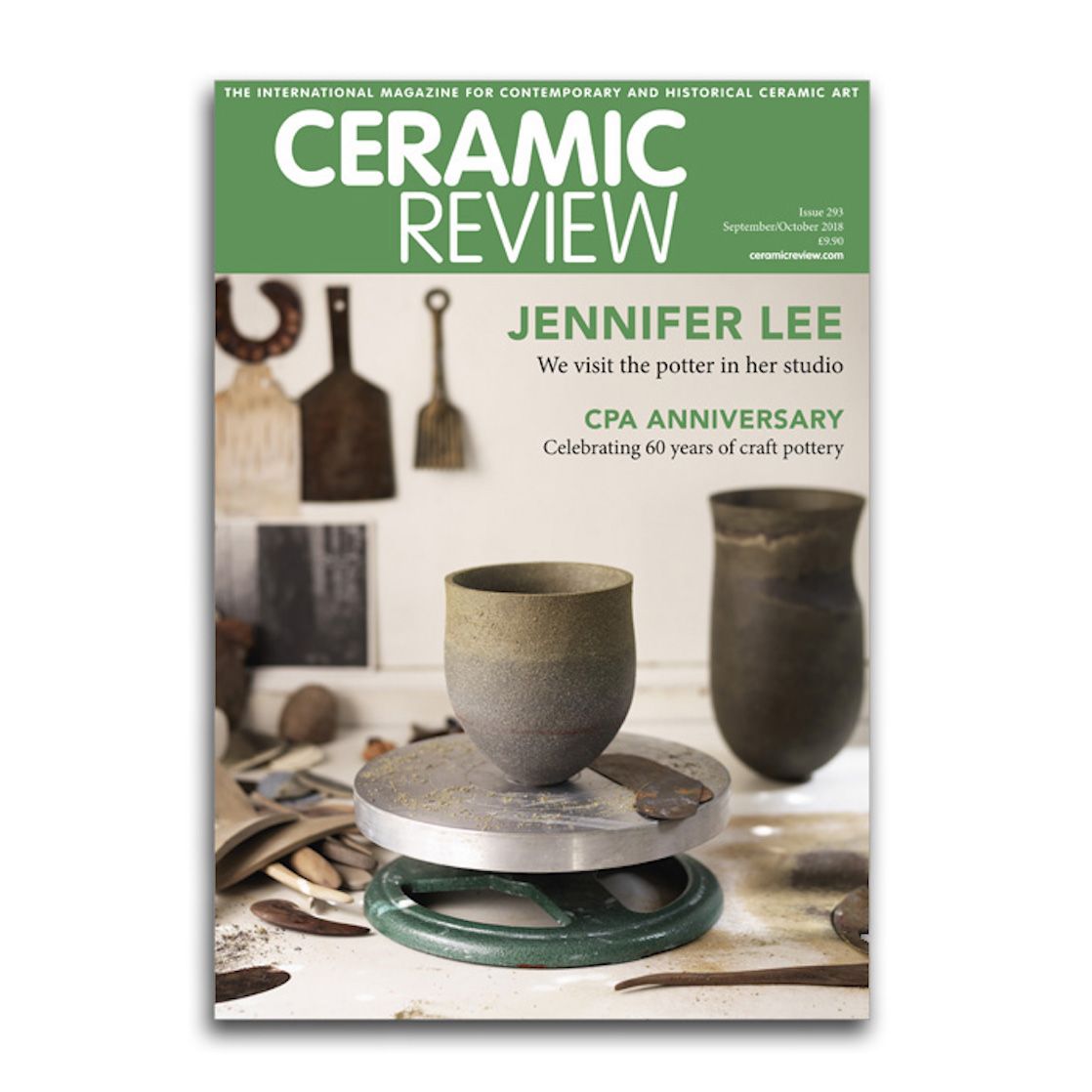Welcome to Ceramic Review
Ceramic Review is the magazine for contemporary and historical ceramics, ceramic art and pottery.
Ceramic Review Issue 334
July/August 2025
Ceramic Review is the magazine for contemporary and historical ceramics, ceramic art and pottery.
July/August 2025
After catching CR’s eye at Ceramic Art London and winning our Highly Commended Newcomer Award, we learn more about emerging maker Rhian Malin’s blue and white porcelain, inspired by traditional Willow Pattern china
After being inspired by my grandmother’s collection of Willow Pattern china, I decided to follow the long history of hand-painting porcelain with cobalt blue decoration. I make elegant wheel-thrown vessels with geometric patterns that give this tradition a more contemporary feel. I aim for form and decoration to work together in harmony, creating a beautiful object to be admired. Each piece is intended to be a work of art in its own right – I’m definitely a ‘form over function’ potter!
I take a mathematical approach to each design. Patterns are either projected onto vessels then painted to accentuate their dimpled contours, or applied by eye. I divide the piece vertically into eighths or sixteenths to make patterns stretch or expand proportionally to each form. All of my work is thrown porcelain, usually with hand-painted cobalt blue underglaze decoration and a transparent glaze. Occasionally I flute patterns into the porcelain and then use blue glazes to pick up the texture of the carved marks. I bisque-fire to 1000°C, then after glazing, fire to 1240°C in an electric kiln.
I discovered ceramics in my last year at Camberwell College of Art, where I studied Three Dimensional Design. In the first two years I used wood, metal and plastic, which I never fully clicked with, but when the Ceramics degree lost its funding at the end of my second year, the workshop became open to students on other courses. I was given a 10-minute throwing demo from a technician and was hooked! I then spent endless hours watching potters throw on YouTube and learning through imitating their movements. I moved on to throwing with porcelain after only a few months and began decorating the vessels I was creating with blue geometric patterns.
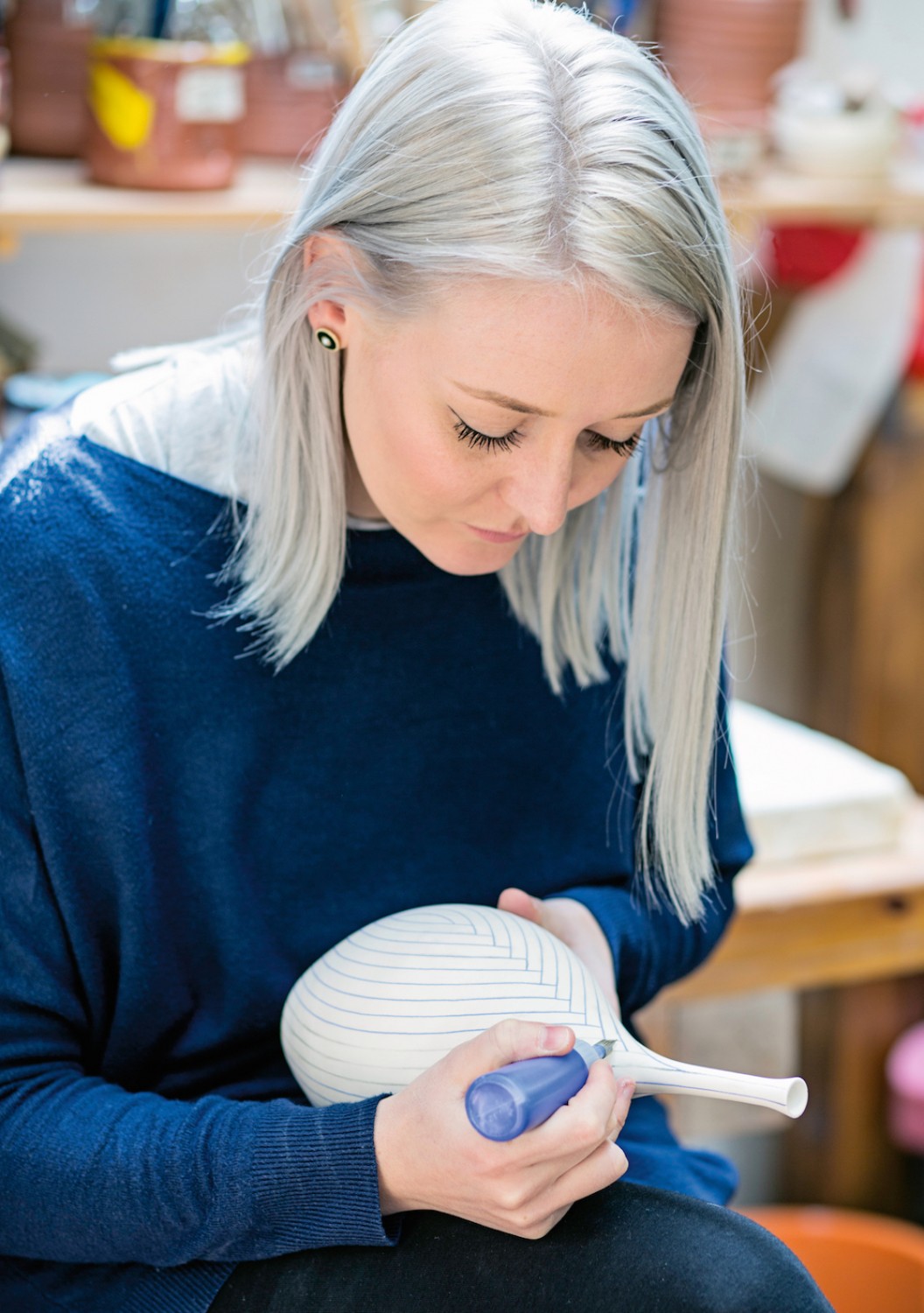
Rhian Malin hand-painting pots. Photo Lucy Barriball
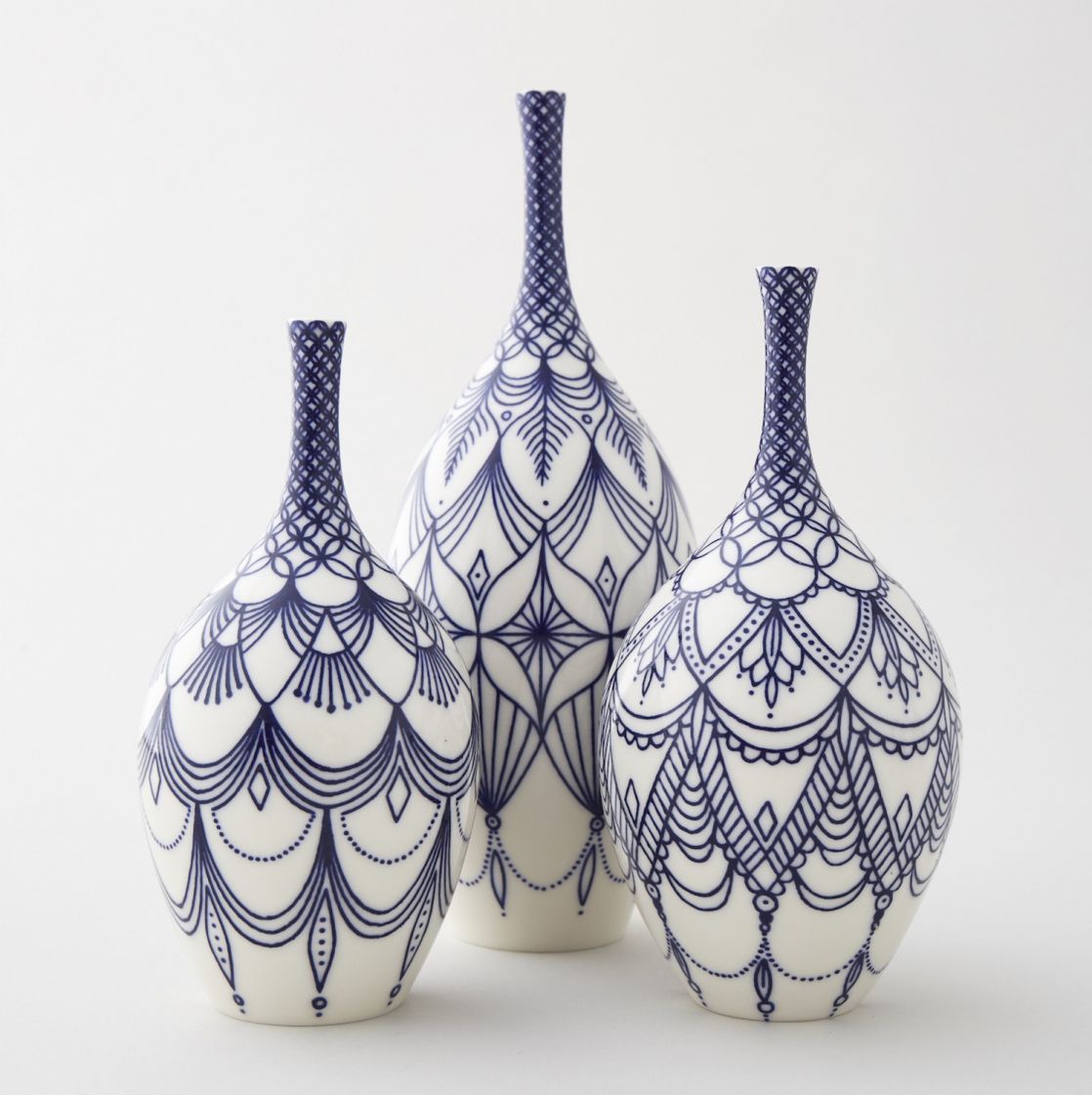
Rhian Malin, Mandala bottles. Photo Yeshen Venema
People often react with disbelief when I tell them my work is all hand-painted. Being a perfectionist is both a gift and a curse, but I probably wouldn’t be able to throw the forms and hand-paint the patterns that I do if I wasn’t. I have very high standards, so I spend a lot of time making sure everything I do is to the highest quality. In that respect, I am happy to be a perfectionist.
I take a mathematical approach to each design. Patterns are either projected onto vessels then painted to accentuate their dimpled contours, or applied by eye.
On the other hand, I obsess over tiny imperfections as opposed to focusing on what has worked, which can sometimes have quite a negative impact. I try to challenge my inner perfectionist through techniques such as squeezing freshly thrown forms to create my Hand Held Vessels and Dimple Jugs, but it is all still done in a very controlled way. I find it hard to let go, which I’m sure is blindingly obvious when looking at my work!
I spent a lot of time in the V&A’s wonderful Ceramics Galleries and always found myself drawn to the traditional blue and white porcelain. Willow Pattern is a Chinese-inspired decoration that became popular on mass-produced tableware in England at the end of the 18th century. Having grown up around my nan’s collection of this china, it felt very nostalgic to me and I wanted to make my own interpretation. I began looking at the Willow Pattern closely, zooming in and distorting details around the borders then projecting them onto my pots in order to paint them.
I’ve been making blue and white vessels ever since, but I now focus more on applying my own original patterns by eye instead. I’m frequently told that people feel nostalgic when seeing my work, because they too grew up with blue and white tableware. This is lovely, because it feels like the process has come full circle.
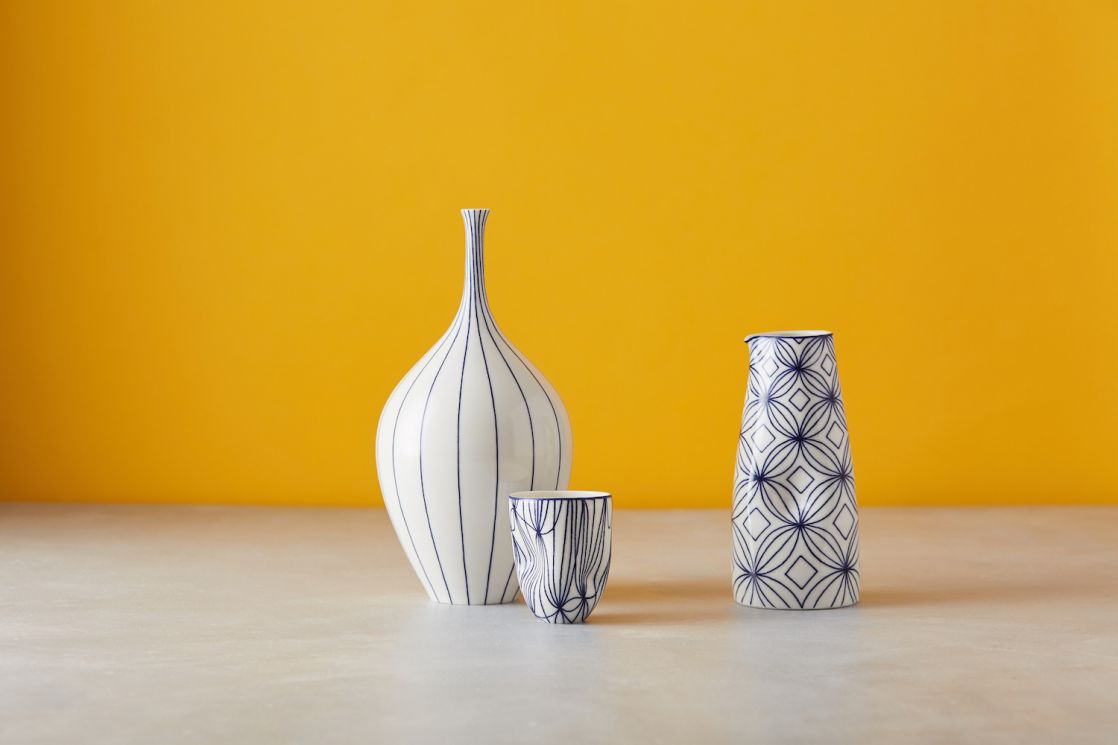
Rhian Malin, linear bottle, hand held vessel, dimple jug. Photo Yeshen Venema
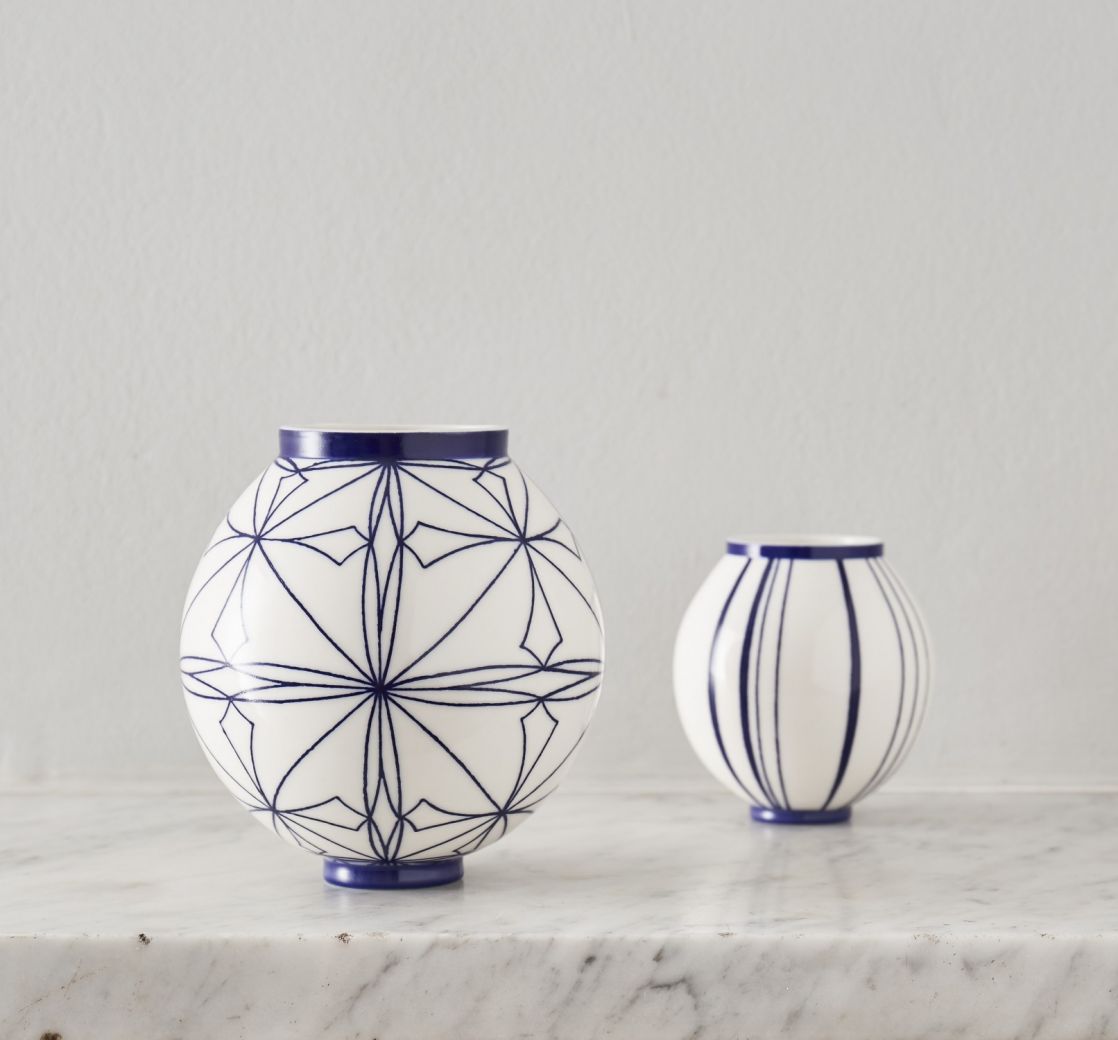
Rhian Malin, moon jars. Photo Yeshen Venema
Each piece is intended to be a work of art in its own right – I’m definitely a ‘form over function’ potter!
I live in Stratford-upon-Avon and until very recently my studio space was at The Ceramics Studio, a few miles away in a village called Alderminster. It’s a shared pottery studio in a converted granary – the building has beautiful character and is an idyllic place to work. It’s primarily set up for teaching pottery classes, but I had a small space with my own wheel, and shared their kiln. I’d been there since graduating in 2014, beginning initially as an Artist in Residence. Leyla Folwell, who runs The Ceramics Studio, took me under her wing and helped with all of my technical queries; she taught me how to run a studio. I’ve learnt so much more about ceramics from being there than I did at university. I’ve just moved into my own studio – I’m at the point where I need more space.
Highlights of my career so far include getting accepted on the Crafts Council’s Hothouse Programme in 2016. It was a significant step in helping me to develop my business knowledge, which was much needed. Most recently, exhibiting at Ceramic Art London for the first time was an amazing experience. Being awarded CR’s Highly Commended Newcomer Award at the show has been the highlight of my year. I have lots of new ideas in the pipeline, all of which are still within the boundaries of blue and white; it’s finding the time to execute them that is the problem. Once I am settled in to my new space, I’m really looking forward to experimenting with more intricate one-off pieces.
Learn more at rhianmalin.co.uk. This article is taken from Ceramic Review issue 293 (Sept/Oct 2018). For more, subscribe below.
